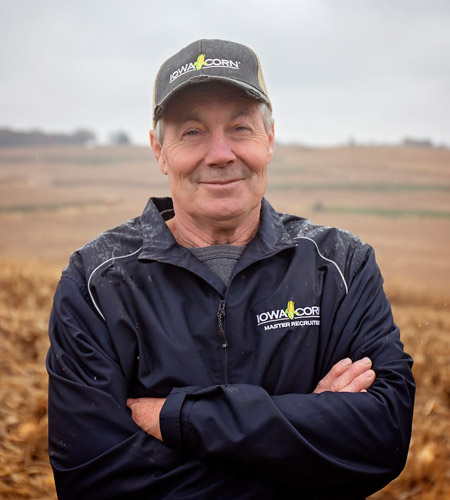In the Loess Hills, topsoil is valuable. It’s important to be open to doing things differently; finding a better way to preserve this land for future generations.

Curt Mether
Monona and Harrison Counties

Farming Operation
- 3rd-generation family farm in Monona and Harrison counties in western Iowa
- Farms corn and soybeans on the steep to rolling Loess Hills
- Farms a variety of soil types, even within individual fields
- President of the Iowa Corn Growers Association
4R Plus Practices Used
- 100% no-till and plants cover crops on as many acres as possible
- Builds his own terraces and tiles a channel of terraces to allow the water to filter through the soil
- Utilizes grassed waterways; borders along fields and creeks
- Maximizes the efficiency of N, P and K; uses stabilizer with anhydrous
- Tests tile lines for nitrates
Results Seen
- Combination of no-till and cover crops has dramatically reduced erosion
- This system has also improved water-holding capacity and water infiltration, which better supports equipment
- No-till minimizes yield variability and makes it possible to grow high-yielding crops on steep ground
- Terraces are overbuilt to absorb and slow down water
- Water coming out of tile lines has minimal nitrates
Plans for the Future
- Working on ways to reduce input costs
- Continue to attend field days to learn what other farmers are doing to build soils impacted by erosion
- Working on ways to further reduce yield variability
Click here to ask Curt a question about his farming operation.
Harvest 2019: Western Iowa Farmer Attributes Record Yields to No-Till
Harrison and Monona County, Iowa, farmer Curt Mether was optimistic about corn and soybean yields throughout the growing season. As he watched the yield monitor, his high expectations were exceeded.
He is thankful Mother Nature wasn’t as harsh on his farms as in other areas of the state, but he attributed this year’s yield advantage to the two decades in a no-till system. “It seems like the first few years of no-till there wasn’t much yield advantage. But back then I was focused on controlling erosion,” he said.
Now he sees cumulative soil health benefits.
Click here for the full story.
Summer 2019: 4R Plus Practices Have Cumulative Effect
On the steep hills of Harrison and Monona counties, Curt Mether has a cropping system that has stood the test of time. He has been no-tilling for more than 20 years and started planting cover crops on as many acres as possible six years ago. This year, the system allowed for timely planting.
“What I realized this spring is that everything that has been done to the ground – the tillage practices and conservation practices like cover crops – made a big difference,” he said. “I think farmers underestimate the cumulative impact of what they do over the course of time. No-till soils have better structure and improved infiltration and water-holding capacity. The soil supported the equipment and that made a world of difference this year.”
Click here for the full story.
Spring 2019: Using Conservation Practices to Manage a Tough Spring
Harrison and Monona County farmer Curt Mether has had a tough spring. A quick snowmelt and excessive rains have damaged some of his terraces, but he knows it could be much worse. In fact, he’s seen the extensive damage south and east of where he farms.
“Our trouble is the water goes down the hills too quickly,” he said. “I have miles of terraces and have been growing crops on these hills with a no-till system for more than 20 years. I started growing cover crops six years ago because I want to rebuild organic matter lost to erosion.”
Mether overbuilds his terraces for years like this and will be doing the repair work himself. “Our terraces mostly held up and did their job of slowing the water down early this spring,” he said. “But there are a few places where the water came down too quickly.”
Click here for the full story.
